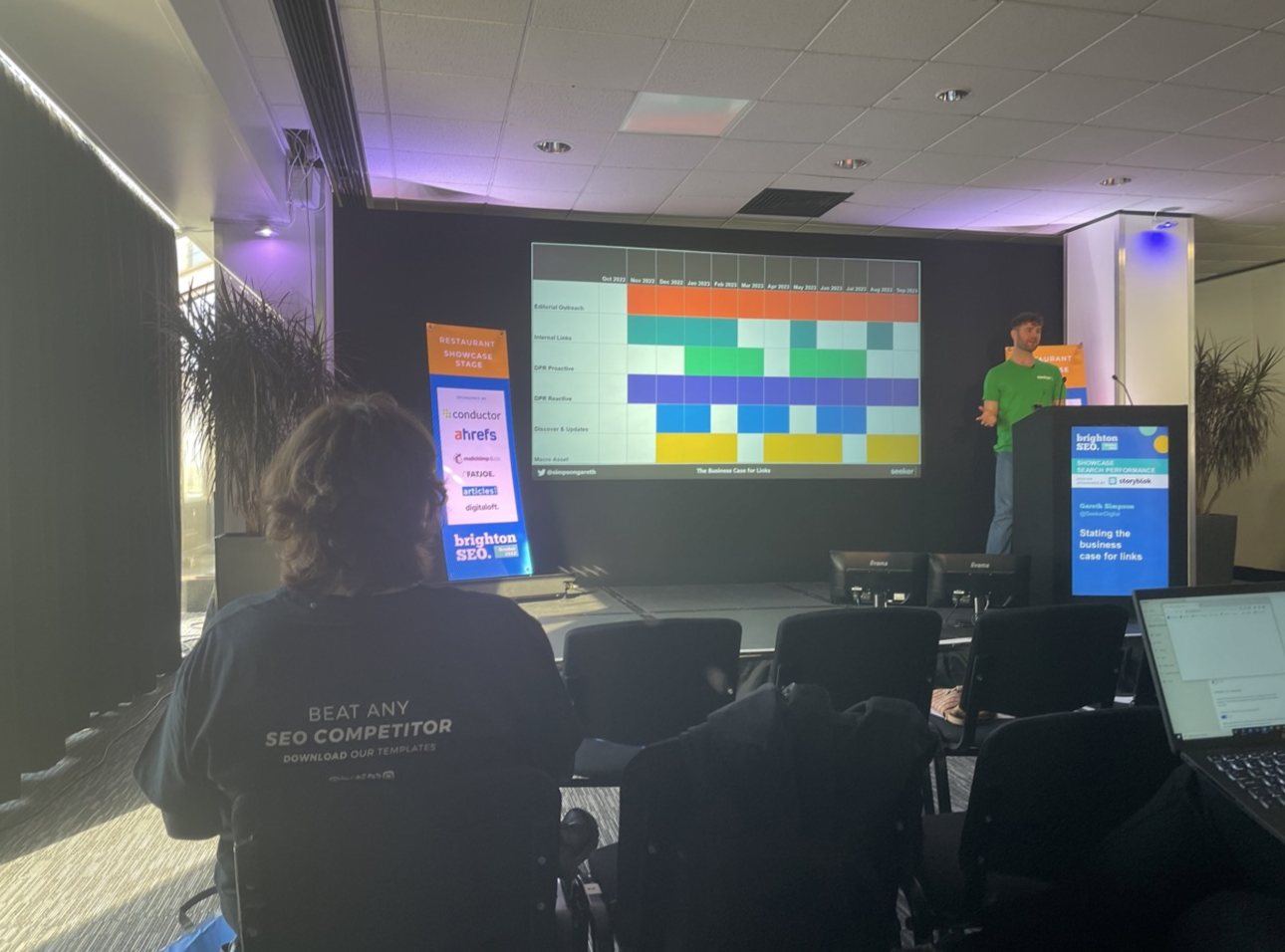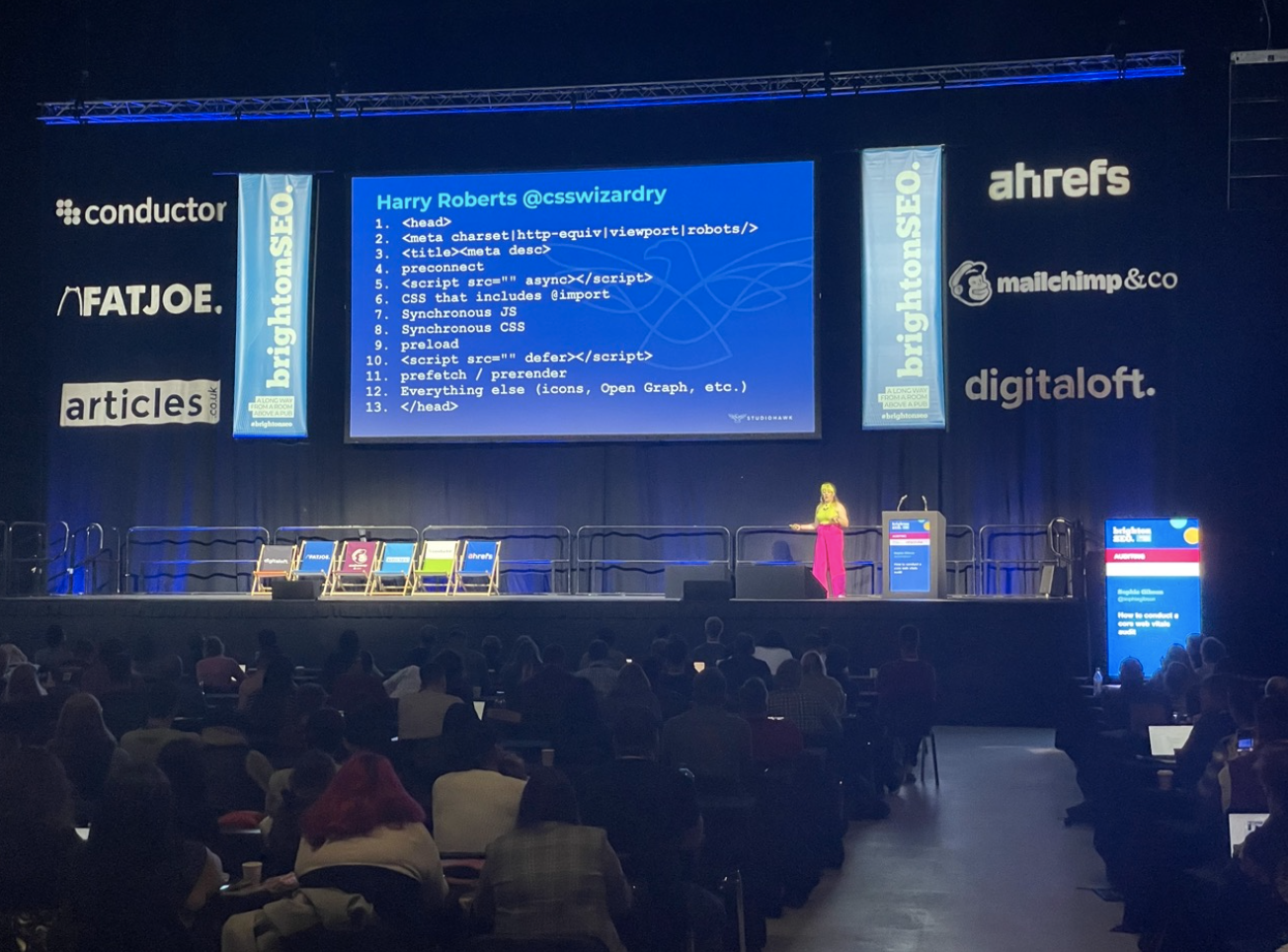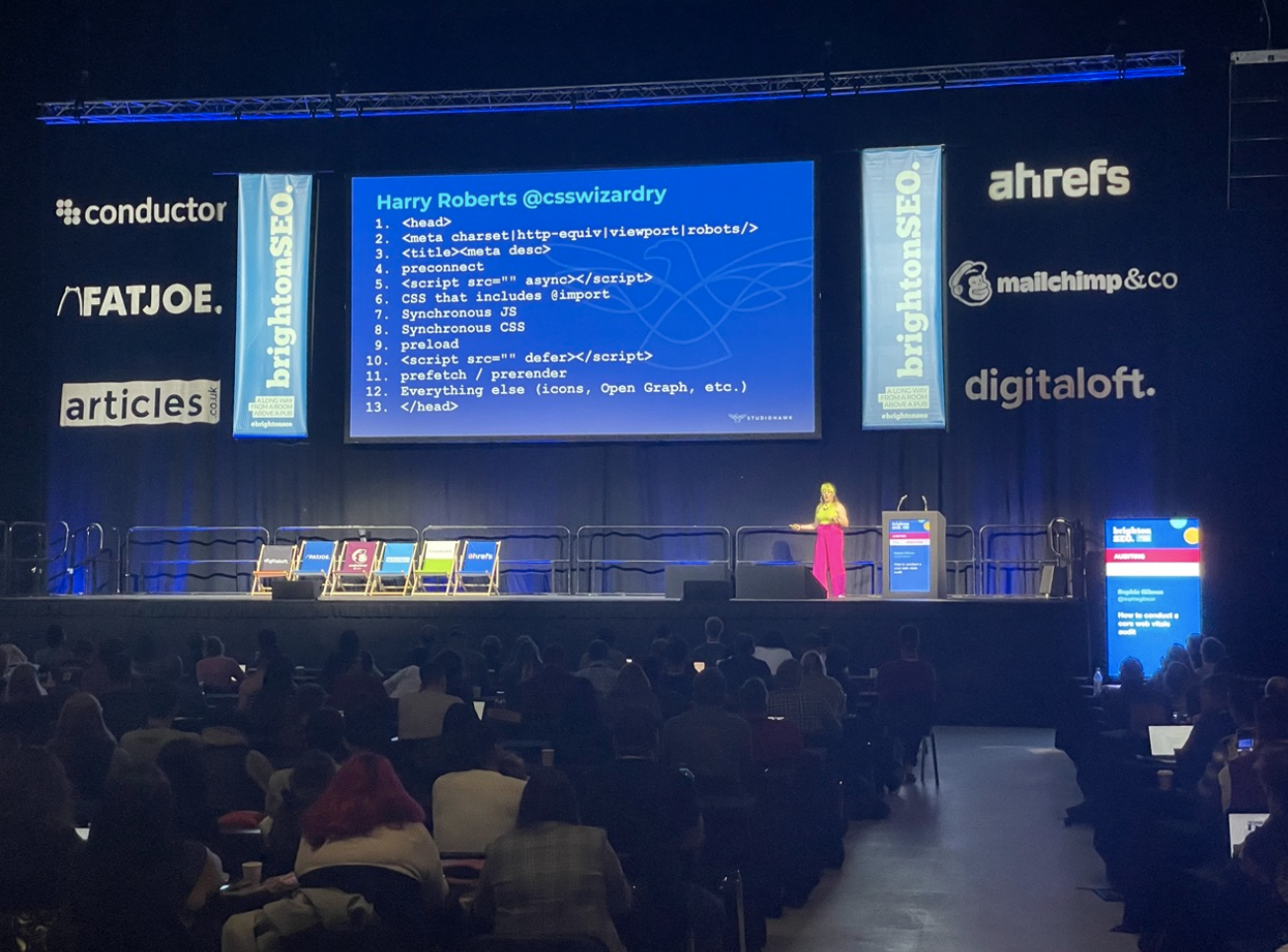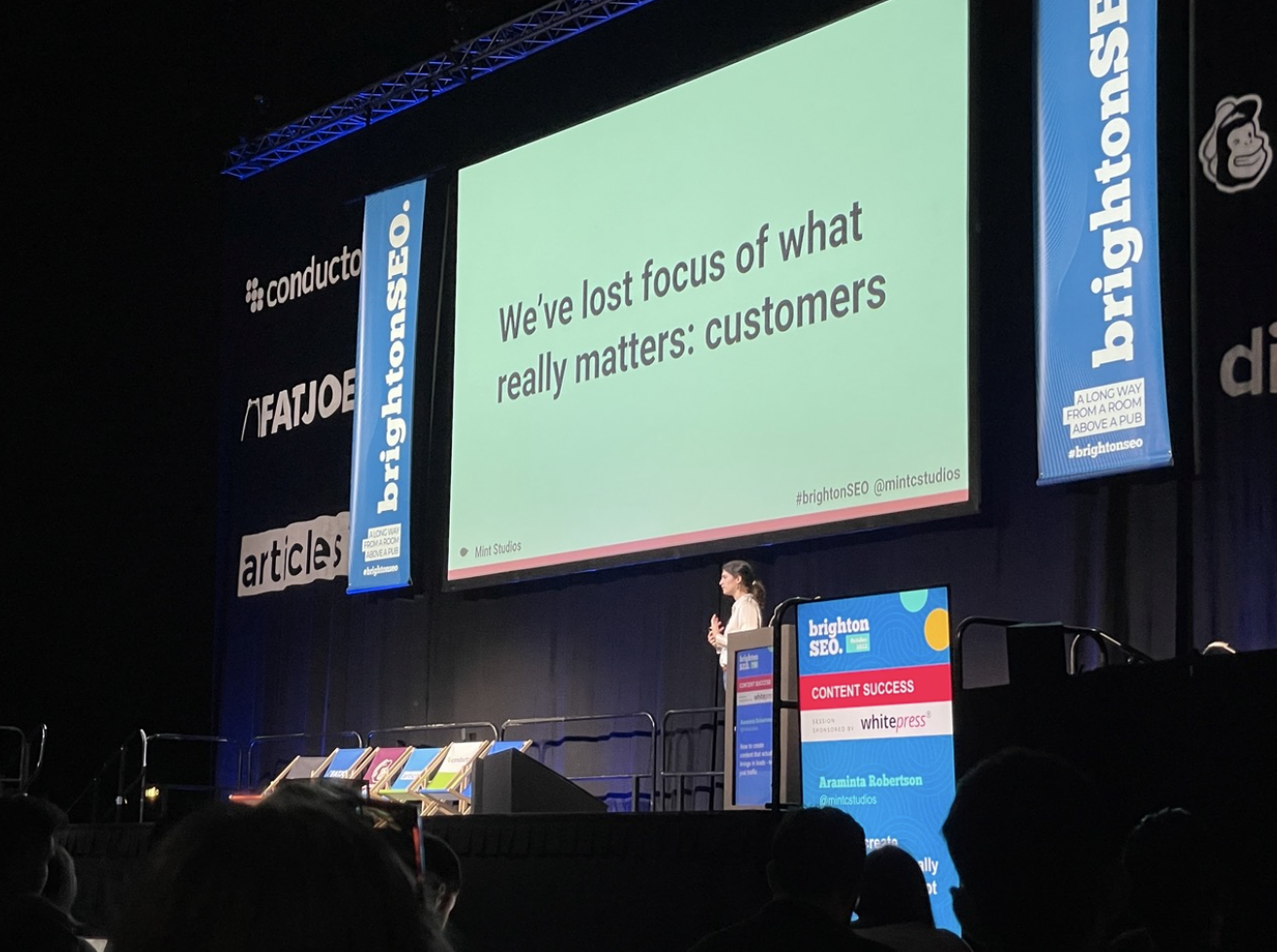Couldn’t make it down to Brighton for Day 1 of brightonSEO? Fear not! StrategiQ’s team of SEO specialists were there to capture the highlights. Here’s our roundup of everything that caught our eye – from content management and auditing to ecommerce and tips for content success.
(Missed the Wednesday sessions? Here’s our roundup of brightonSEO October 2022 – Paid Social Show – Fringe Event.)
SHOWCASE – SEARCH PERFORMANCE- SPONSORED BY STORYBLOK
Gareth Simpson – Stating the business case for links
There is a debate raging about the value of link building in today’s digital space. But it is not a question of whether you should be a link builder, more HOW.
First emerging as a patented term by Google in 1998, but heavily used and significant today, link-building and digital PR are key foundational approaches to brand building, with expertise, trust and authority (EAT) signifying the importance of trustworthy links.
While your link profile is possibly your strongest asset in your bid to compete online, it is your least protected. Meaning that it is vulnerable and quick to change. The difficulty in tracking the ROI on it provides an even greater challenge for marketers to justify including it as a core activity in their strategy. However, there are ways to quantify it using data:
Domain Level Gap – using the data from competitor analysis from ahrefs Domain Rating, Ref domains Kws etc. How does the client compare to their competitors?
Page level gap – Page level metrics are crucial, has a correlation with traffic
Quantifying the gap – keyword difficulty is a good metric, gives estimations of links, using the UR distribution can help build a picture of what is required to rank on page one. Opportunities in
Closing the gap – Using calendar approach to layout, link forecasting and modelling the required number of links to rank on page 1 vs the competitor strategy.
You can then calculate the ROI and potential revenue gains from the activity – making the perceived ‘unquantifiable’ a firm and favoured tool in your integrated strategy.

Will Critchlow – What we can learn from losing tests – the importance of paying attention to negative outcomes
Anyone who works in SEO will agree on one thing, it is an absolute adventure. We don’t ever really know exactly what works, and we don’t know which updates are around the corner to send us in a new direction.
However, SEO testing allows us to map individual changes/hypothesis to specific business outcomes. Here’s how to run an SEO test:
- Take a section of pages with a similar template
- Hypothesis a change
- Apply the change to some of those pages – the controls and variant. Statistically similar
- Set up the running test on the variant pages
- Compare the performance of pages
Search AB testing is different to Conversion Rate Optimisation (CRO) User Testing. The core difference is that CRO focuses on the bottom funnel and SEO is focused on opening the top. Full funnel testing combines the two:
Since we’re on an adventure, there are bound to be ups and downs, which is why the business case for search testing is easy to justify when you’re winning – SEO activity turns investment into revenue. Happy days. However, it is important to remember that negative changes are learnings. We know what not to do, whereas competitors don’t, and neutral outcomes save time and money and can simplify a roadmap of activity.
Control tests are also key for us to monitor the impact of SEO changes and actually validate. Combining this with a thorough approach to EAT will prevent nominal and unnoticeable changes to ranking.
Once you have your testing protocols confirmed to improve the quality of your results and learnings, you can then attribute tests to business outcomes, leaving you to then focus on the cadence of testing.
Matt Allfrey & Carl Sadecki – Delivering total performance in B2B through content-led SEO
The total performance of your marketing strategy is a simple equation: Creative x Digital x Media. So where does the SEO mix sit, and what does the balance between content and tech look like?
The first stage of a content SEO strategy is traditionally to audit content – keep, revise, delete. Tech standards can be monitored using performance data and backlink data.
These audits help to identify potential content opportunities that could dramatically increase visibility through revising.
Plus discover legacy content thaty is impacting and holding back performance. Similarly, cannibalising content needs to be eliminated by merging pieces.
Performing a regular content gap analysis will help your content SEO approach remain sharp and relevant:
- Competitors – identify where the successes are
- Audience – what do they need
- Product – use it and understand
- Intent – look for the nuances in language of SERPs
Once you have performed your audit it’s time for some content creation starting with a creative ideation session back by keyword research that will generate a working title. Then check out the SERPS – what do they say? How can we beat the competition?
Once you’re ready for your content production, depending on how your team is structured, you may be briefing or creating yourself, but always ensure the skeleton layout and meta data are clear from the start.
You can often find handy clues from your paid strategy as to which keywords have the highest conversion intent levels.
You can also test the performance of your new content by running a dynamic search campaigns with a small budget on content that allows an understanding of performance insights.
You can also implement a regime of data studio and Google Trends analysis and search console impressions to analyse the success of your content
Don’t forget to republish your content to get the most value from it.
AUDITING – SPONSORED BY ABSOLUTE
Lucy Dodds – You want me to look at HOW MANY pages?!’ How to do a content audit for thousands of URLs

What is the best approach to auditing content? Where do you start? And how do you establish a framework?
Here are ten simple steps:
1. Brand research
Hosting a session with others in the business including sales and customer service, always asking the question – What do customers want to know?
2. Audience research
Speaking to customers to ensure content meets their needs and finding ways to incentivise it.
3. Content audit statement
Sets out the why of the audit and by keeping the statement front of mind ensuring that we meet the objectives of it.
4. Categorising URLs and making notes for each
What parts of the business are naturally segmented, which perform well and where do they sit in the marketing funnel.
5. Everything else – general usage pages including the contact pages and pages from the footer.
6. Pulling data
Extracting everything from your preferring analysis software, including Screaming Frog; ahrefs; SEMRush, Google Search Console and Google Analytics and combine it into one central point of truth. Then from the data add an action: Keep, Improve, Remove, Merge.
7. Go beyond search
Checking content with other stakeholders – are pages used by customer service/sales?
8. Highlight trends
Reviewing clicks, impressions and links. Using conditional formatting to easily visually review data.
9. Work in batches
Work through the previous categories of content to focus on the key pieces. Small batches will help to reduce fatigue. Don’t fix what’s not broken but identify pages where some metrics are winning but others are losing – this equates to opportunity.
10. Check internal links
Just because data is showing 0, doesn’t mean no users click internally. You then need to decide to remove or redirect – redirects should be to the closest page.
Sophie Gibson – How to conduct a core web vitals audit
The principles of a Core Web Vitals (CWV) audit are simple: Benchmark > Investigate > Test
Benchmarking
Largest Contentful Paint – the time it takes for biggest thing to be visible
First Input Delay – how fast does the page respond to user interaction?
CLS – how stable is the page during the loading process?
Benchmarking
- Split the site into page templates and then collect the URLs for each template
- and get the data and document, adding to a spreadsheet for each of these using:
- GTMEtrix
- Google Lighthouse
- Scale: Using Screaming Frog using Pagespeed insights API
- Pagespeed compare can do bulk upload
Investigate
What is happening and why is it happening? Often the tools will provide the recommendations, GTMetrix and Lighthouse will give pointers as well potential savings.
- It is worth asking yourself three key questions:
- How many resources?
- What is the largest resource?
- How is it loading and are there any render blocking resources?
Remove the removable
Ask yourself whether it is essential. If it doesn’t need to be on the page then remove it. if it does, then should it be tracked more closely?
Delay the delayable
What can we delay to load later in the process – e.g. delay a chat bot loading. Scripts can be deferred and images can be lazy loaded
Restructure the restructurable and compress the compressable – images are often a prime offender.

Test
Using the network tab, block request URLs to test the before and after of a lighthouse test. This helps to validate the change with measurable impact.
Prioritise
Use a difficulty matrix to determine which tasks to take first, accounting for time and resource, complexity, low resource tasks (direct control images, marketing scripts, Google Tag Manager, and high resource tasks – html, hardcoded scripts, removing dependencies.
Categorise into the four quadrants of time/resource and complexity and ignore the super high, thinking about a scalable application and considering how benchmarking will work moving forward for each CWV. Hypothesise the potential impact with ease as a good method of scoring the impact.
And finally, when it comes to CWV Don’t let perfect be the enemy of good. Focus on the key pieces that will make a difference.
Grace Frohlich – The ultimate SEO maturity audit
What is a maturity audit?
A maturity audit is a framework to determine the relative maturity of a website within an industry that gives a score.
The framework for a maturity audit is as follows, each producing a score from 1-5.
Technical compliance > site speed > competitors > onsite content> link profile > search opportunity > tracking
Technical compliance
This is a mini tech audit that prioritises the key factors. Indexation (xml sitemaps, robots, JS rendering), ranking blockers(Redirect issues, duplicate or missing metadata), appearance in SERP (Schema markup, canonicals, hreflang). Give each category a score and average
Site speed
Core Web Vitals. LCP <2.5s, FID <100ms, CLS <0.1
Screaming Frog, the pagespeed insights API is great for measuring at scale
Competitors
Brand search trend
How does our brand term’s search visibility compare with competitors? Google Trends is good for this. What levels of organic traffic do we attract and what is our share of voice?

On site content
How often is content updated and/or how often is it created, and which of these pages are driving the most traffic? Is traffic evening distributed? Categorise the pages based on your findings. Identify which indexable pages are driving less than ten sessions per month.
Link Profile (Internal linking & backlinks)
Internal links to important pages and site structure. Google Search Console links report will highlight pages with most links, crawl data can also be used.
Backlinks; check total volume and root domains and how this compares to competitors. Quality is important too, how does domain ranking vary across the backlinks coming in? Check for any links that carry a penalty risk including paid for links.
Search opportunity
It is important to establish a clear process for keyword identification and mapping. Where are the organic conversion paths – how are users from organic traversing the site to convert?
The SEO maturity audit can be repeated across multiple sites amd opportunities defined from it, compiling a roadmap to success.
Turnkey solution stakeholder management: Satomi Masters
Isn’t it great when you give someone an ‘aha!’ moment? Well, when engaging stakeholders, it is really beneficial to give them just one of these – – something you see every day but don’t really associate. It creates a connection between things.
A simple ‘aha!’ could be data which you see everyday, but they do not – sometimes the simpler the source the better and nice and easy to digest data – e.g. competitor meta data for a SERP battleground.
Then there is the slightly shocking ‘aha!’ – where you provide additional/deeper insight. Something we use daily but we don’t know the exact details. Highlight the problem and then hint at the solution. Open the new world and clarify the idea. Give something new to them but that you own.
Create strategies that upsell | Judith Lewis
Creating strategies that upsell comes from giving clients a taster of what they will get and enticing them with something with a high output that isn’t too time intensive. Seems straightforward enough, right?
Integrating channels is the easiest and most effective way of upselling, as you can bolt on additional services and increase all at once, depending on the need.
It all comes down to strategy. What are we doing? Who are we targeting? Firstly,
start with personas – not many do it well enough. Basic personas can be done in minutes and focus on: Audience – Strategic Imperatives – Key Social Channels
Before you can successfully upsell, you need to understand the fundamentals – what does the client want to achieve.? We should reflect that back on to them making them realise that we understand the need and to make them feel part of a partnership. Define a concrete goal backed up by broad aspirational goals to delight and excite.
SUCCESS
Greg Gifford – Pullling back the curtain: how to run a successful agency
When running a successful agency, true wins come from people and processes. Making sure the right people are in the right seats. A Culture Index helps to hire the right people for the right roles and creates a pattern of a person’s behaviour.
Running a bi-annual survey is important to check on the mental vibes of the team and identify common areas of concern. Use the feedback to develop training programs and tangible means of improving based on those on the ground.
A profit share bonus scheme is a powerful way to keep everyone motivated and invested in the growth of the agency, and having it pay out twice a year means interest levels remain high.
If you focus on your team your team will be happier, do better work and delight clients. Doing this by implementing solid, documented processes is key. In a successful agency, each person does everything – SEO’s account managing and teams working in Pods of 5 with a Team Lead that mentors and oversees quality.
Everything is based on a tactical framework of recurring activities fuelled by a profitability monitor which helps to monitor performance but also know where to scale. Knowledge of how much a person is worth for profit when fully utilised is also useful information when making resourcing decisions.
Running weekly task data downloads against a weekly schedule meeting to check people are getting things done, but not overburning and to also identify when people are struggling which allows additional training and support to be given. Reduce the number of meetings, high efficiency and use software to guide the meeting and set time limits and boundaries.
All sales calls include a subject matter expert for the relevant enquiry which can as much as double the sales close rate. You can also create metrics and scorecards to speed up the audit process of new business, making quick decisions about whether partnerships are viable and where they sit on the value chain.
Running a successful agency means taking time to galvanise your team. This is fuelling by factoring in quarterly and annual planning days off site, backed by in depth team manuals that provide everyone with the documentation that need to refer to about processes and expectations.
Each Team Lead should have their own Captain’s Log reflecting utilisation and financials within that team, tracking trends and identifying opportunities and pinch points.
When you need to outsource, do it sparingly and tactically, as it can be cheaper but carries the natural risks of quality control and client relations. It can however be really handy when you need to scale at pace in a particular area.
Don’t forget that referrals can come from competitors, so don’t annoy them. Exclusivity can work in your favour. Conferences are the biggest source of leads, but other lead gen works well; podcasts, webinars all help to generate leads especially if you share helpful and engaging content.
Finally – focus on getting exposure and clients will come.
Araminta Robertson – How to create content that actually brings in leads – not just traffic
Content has lost focus on what really matters: customers
Why do we struggle to generate leads form content?
Most content strategies don’t focus on customers. It doesn’t talk to the audience, the targets. It doesn’t have expertise, so it blends in with the rest. And on top of all this – it’s not tracked.

Solutions: Content Strategy for Customers
- Target the bottom of the funnel users
- Talk to the audience by writing to the level they require
- Create expertise
- Interview an expert on the subject
Tasha Antwi – Using brand archetypes to build search strategy
- Google has evolved from basic keywords to conversational journeys with the engine. This means it’s important to create a seamless search experience – and audience needs to be the first thing thought of.
- Think beyond the keyword – understand how search plays into the multi-faceted journey to conversion
- Create a keyword universe that fully maps your targets across the buying cycle and funnel
- You need to understand how your content can add value to your customers. Target their interests and challenges
Brand Archetypes – a representation of your brand based on 12 human desires, claims people buy with emotion and justify with logic. Do they?
How do you want customers to feel before and after?
Take your customers on a transformation. People don’t buy products, they buy lifestyles. Sell them the lifestyle they want to emulate. TikTok is starting to influence google search trends. But TikTok can help sell the lifestyle.
Summary
- Audience First
- Leverage data & search insights
- Seamless discovery experience
- Fit into a wider media strategy
Katie Swann; Data Pitfalls: Keeping PR Campaigns on the right side of digital PR Twitter
Viral campaigns are hard to create, predict and impossible to control. PR needs context and to relate to the results. This will help:
HICCUP analogy:
H – Headline
Don’t fix a headline based on bad data. Change it.
I – Intention
Ensure the original source data has good intent and is matched to what we are trying to achieve
Check your data isn’t misleading e.g. high volume data for the same name
C – Cover your Bases
Ensure you’re not going to miss something that will cause issues
C – Check your data
Use reliable online data sources. Check dates is it recent/relevant? Will it replicate? Read the fine print. Include it all in your methodologies
U – Understanding
Ensure content is easy to understand and isn’t open to misrepresentation. Once the campaign is live, you struggle to control the narrative
P – Proof, proof, proof
Incorrect spellings can be deadly for PR and easily derail a campaign
Proof for: Spelling (names), numbers, common sense, normalise results against a relevant factor when segmenting data. Conclusions – what’s the story? Is it clear?
Krista Seiden – Why SEOs should love (not fear) GA4
GA3 is based on an old codebase dating back to 1995. It’s customisable but lacks structure. GA4 focuses more on structured events and parameters.
7 Reasons to love GA4:
- GA4 gives us better clarity between users and sessions through the traffic acquisition and user acquisition reports. These can be combined to better understand user acquisition and behaviour.
Tracking paths to conversions is easier, as GA4 shows the number of touch points needed to convert and helps to paint the picture. - GA4 makes data analysis easier
More search engines are included natively within default channel groupings
More default channel groupings 18 instead of 10. Could help to reduce direct blackhole. Engaged sessions & engagement rate gives better clarity - Analyse helpful content with GA4
Enhanced measurement provides more data for content analysis
Real time helps to give a more granular view of the now
Pages & Screens can be used to show both page title and URL - Report customisation. Build any report you want – they are all customisable to what you need
Custom reports can apply filters to the individual elements and enables the reports to be bespoke for a team/department - Explore your data in depth
Explore is a deep dive analysis tool that has multiple functions for detailed analysis
Pathing analysis works from both the start and the end - Integrations make GA4 stronger
Free BigQuery export of raw event data - Advanced Reasons
In-App and cross-platform – GA4 can be leveraged across web and mobile through unified SDK
GA4 with server side GTM. Server Side becoming more prominent
Measuring CWV with GA4 using GTM Template by Simo Ahava
